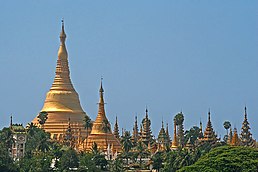**Historical Development**:
– Yangon was founded as Dagon in the early 11th century by the Mon people.
– King Alaungpaya captured Dagon in 1755 and renamed it Yangon.
– The British captured Yangon in the Second Anglo-Burmese War of 1852, leading to its transformation into the commercial and political hub of British Burma.
– After Burma’s independence in 1948, many colonial-era names were changed to more nationalistic Burmese names, and the city’s English name was officially changed to Yangon in 1989.
– Yangon has been a focal point for major anti-government protests, including the 8888 Uprising, Saffron Revolution, and events in 1974, 1988, and 2021.
**Geography and Climate**:
– Yangon is located in Lower Burma at the convergence of the Yangon and Bago Rivers, about 30km from the Gulf of Martaban.
– The city’s coordinates are 16°48 North, 96°09 East, and it is situated 23 meters above sea level.
– Yangon has a tropical monsoon climate with a lengthy wet season from May to October and a dry season from November to April.
– Average temperatures range from 29 to 36°C for highs and 18 to 25°C for lows, with the city being prone to tropical cyclones throughout the year.
– Intertidal flat ecosystems occur adjacent to the city due to its location on the Irrawaddy Delta.
**Infrastructure and Urban Development**:
– Yangon has faced challenges in providing adequate infrastructure compared to other major cities in Southeast Asia.
– The city government placed about 200 notable colonial-period buildings under the Yangon City Heritage List in 1996 for preservation.
– Historic buildings in central Yangon have been renovated, but satellite towns lack basic infrastructure.
– Major building programs have resulted in new bridges and highways linking the city to its industrial back country.
– Successive governments have built satellite towns to accommodate the expanding population, with Greater Yangon now covering an area of nearly 600 square kilometers.
**Architectural Heritage**:
– Downtown Yangon is renowned for its leafy avenues and fin-de-siècle architecture, boasting the highest number of colonial period buildings in Southeast Asia.
– Most downtown buildings are four-story mix-use structures with 14-foot ceilings, including notable examples like the former High Court, Secretariat buildings, St. Paul’s English High School, and Strand Hotel.
– Preservation efforts include a heritage list of old buildings, a moratorium on demolition, and initiatives by organizations like the Yangon Heritage Trust to protect the city’s architectural heritage.
**Socio-Ethnic Dynamics and Contemporary Challenges**:
– Yangon’s ethnic makeup has become predominantly Burmese since independence, with declining South Asian and Anglo-Burmese populations.
– Recent events like the 2021 coup d’état and the COVID-19 pandemic have significantly impacted life in Yangon, leading to protests, lockdowns, and economic slowdowns.
– The city has struggled with challenges such as providing 24-hour electricity, regular garbage collection, and basic infrastructure in satellite towns.
– Despite the shift of the administrative capital to Naypyidaw, Yangon remains the largest city and the primary economic and cultural center of Myanmar.
Yangon (Burmese: ရန်ကုန်; pronounced [jàɰ̃.ɡòʊɰ̃]), formerly romanized as Rangoon, is the capital of the Yangon Region and the largest city of Myanmar (also known as Burma). Yangon served as the capital of Myanmar until 2006, when the military government relocated the administrative functions to the purpose-built capital city of Naypyidaw in north central Myanmar. With over five million people, Yangon is Myanmar's most populous city and its most important commercial centre.
Yangon
ရန်ကုန် Rangoon | |
|---|---|
City | |
| Yangon City | |
Clockwise from top: Shwedagon Pagoda, aerial view of central Yangon, colonial-era buildings along Strand Road, the Karaweik at Kandawgyi Lake, Yangon City Hall, Yangon High Court | |
| Coordinates (Asia/Yangon): 16°47′42″N 96°09′36″E / 16.795°N 96.160°E | |
| Country | |
| Region | Yangon Region |
| Settled | c. 1028–1043 CE |
| Government | |
| • Mayor | Bo Htay[citation needed] |
| Area | |
| • Urban | 598.75 km2 (231.18 sq mi) |
| • Metro | 10,170 km2 (3,930 sq mi) |
| • Rank | division |
| Population | |
| • Urban | 5,160,512 |
| • Urban density | 8,600/km2 (22,000/sq mi) |
| • Rural | 2,200,191 |
| • Metro | 7,360,703 (Yangon Region) |
| • Ethnicities | List of ethnicities |
| • Religions | List of religions
|
| Demonym | Yangonthar |
| Time zones | UTC+06:30 (Asia/Yangon or Asia/Rangoon) |
| UTC+06:30 (Myanmar Time) | |
| Area code | 01 |
| Geocode | Yangon |
| ISO 3166 code | MM06 |
| Vehicle registration | YGN |
| Website | yangon |
Yangon boasts the largest number of colonial-era buildings in Southeast Asia, and has a unique colonial-era urban core that is remarkably intact. The colonial-era commercial core is centered around the Sule Pagoda, which is reputed to be over 2,000 years old. The city is also home to the gilded Shwedagon Pagoda – Myanmar's most sacred and famous Buddhist pagoda.
Yangon suffers from deeply inadequate infrastructure, especially compared to other major cities in Southeast Asia, such as Jakarta, Bangkok or Hanoi. Though many historic residential and commercial buildings have been renovated throughout central Yangon, most satellite towns that ring the city continue to be profoundly impoverished and lack basic infrastructure.










